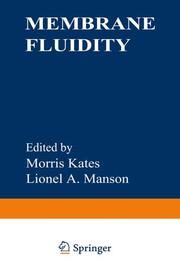Detailansicht
Membrane Fluidity
Biomembranes 12
ISBN/EAN: 9781468446692
Umbreit-Nr.: 6590437
Sprache:
Englisch
Umfang: xxii, 694 S., 3 s/w Illustr., 694 p. 3 illus.
Format in cm:
Einband:
kartoniertes Buch
Erschienen am 29.04.2012
Auflage: 1/1984
- Zusatztext
- The aim of this book is to bring together in one volume the current research and thought on the concept of membrane fluidity as a biological phenomenon. The invited articles are intended to review recent develop ments in the areas of membrane research covered and to summarize the current concepts and theories in those areas. The authors have been given ample opportunity to present their thoughts and speculation on membrane fluidity and related phenomena in a more expanded form than is usually possible in reviews of this type. It is hoped that this approach will have a stimulating effect on research and theoretical development in the biomem brane field. The chapters in this book are arranged in three sections, the first of which covers physical studies of membrane fluidity and related phenomena on the molecular level. Included are chapters on intermolecular hydrogen bonding between membrane lipids, thermal analysis of membranes, appli cation of fluorescence and NMR spectrometry to the study of membrane fluidity, and the effect of drugs and other compounds on membrane stability and fluidity. The second section deals with the regulation of membrane fluidity in microorganisms, plants, and higher organisms by factors such as tem perature, fatty acid chain length, lipid desaturation, and polar head group structure.
- Kurztext
- InhaltsangabeI. Physical Studies of Membrane Fluidity and Related Phenomena.- 1 Intermolecular Hydrogen Bonding between Membrane Lipids.- I. Introduction.- II. Evidence for Intermolecular Hydrogen Bonding.- A. Phospholipids.- B. Sphingolipids.- C. Glyco-glycerolipids.- D. Cholesterol.- III. Influence of Intermolecular Hydrogen Bonding on Membrane Structure.- A. Lamellar to Nonlamellar Phase Transitions.- B. Phase Separation or Domain Formation.- C. Interactions with Proteins.- IV. Control Mechanisms for Membrane function.- A. Regulation of Hydrogen Bonding by Change in Environment.- B. Regulation of Hydrogen Bonding by Enzymatic Alteration of Lipid Composition.- V. Summary.- VI. References.- 2 Thermal Analysis of Membranes.- I. Introduction.- II. Thermal Analysis.- A. Techniques.- B. Application of Differential Thermal Analysis and Differential Scanning Calorimetry to the Study of Membranes.- C. Thermal Analysis and Membrane Fluidity.- III. Analysis of Model Membranes.- A. Factors Which Affect the Transition Temperature of Model Membranes Containing One Phospholipid.- B. The Interaction of Other Compounds with Lipids in the Bilayer.- C. Mixtures of Lipids in Model Membranes - Phase Diagrams.- IV. Biological Membranes.- A. Membranes from Prokaryotic Cells.- B. Membranes from Eukaryotic Cells.- V. Summary.- VI. References.- 3 Fluorescence Polarization Studies of Membrane Fluidity: Where Do We Go from Here?.- I. Introduction.- II. Theoretical Perspective.- A. Polarization and Fluidity.- B. Dynamics of Probe Motion.- C. Relationship of Fluorescence Lifetime and Measured Anisotropy.- III. Fluorescence Polarization in Heterogeneous Systems.- A. A Dilemma.- B. Strategies for Localization of Probes in Heterogeneous Systems.- IV. Asymmetry.- A. The Surfaces of Serum Lipoproteins as Model Monolayers.- B. Impermeable Probes.- C. A Mathematical Approach.- V. Lateral Organization.- A. Structural Basis for Lipid Organization.- B. A Selection of Biological Evidence in Support of Membrane Domains.- C. Fatty Acids and Membrane Domains.- D. Probe Partition.- VI. Resonance Energy Transfer.- VII. Fluidity and Mobility.- VIII. Summary.- IX. References.- 4 Conformational and Motional Properties of Lipids in Biological Membranes as Determined by Deuterium Magnetic Resonance.- I. Introduction.- II. Properties of Membrane Lipids.- III. Deuterium NMR of Ordered Systems: Observables and Observing.- IV. Acholeplasma laidlawii B: A Simple Biological Membrane.- V. Dependence of Molecular Ordering on Position along the Fatty Acyl Chain.- VI. The Spectra of Gel-State Lipid.- VII. The Use of Spectral Moments in Analysis.- VIII. The Influence of Cholesterol.- IX. Protein-Lipid Interaction.- X. Effects of Membrane-Active Drugs.- XI. Prognosis.- XII. References.- 5 Fluidity of Cell Membranes in the Presence of Some Drugs and Inhibitors.- I. Introduction.- A. Fluorescence Measurements.- B. Macroscopic Viscosity Measurements.- C. ESR Spectroscopy Using Spin Labels.- D. Differential Scanning Calorimetry.- E. NMR Spectroscopy.- F. Infrared Spectroscopy.- G. Raman Spectroscopy.- H. Addendum.- II. Action of Local Anesthetics on Red Cell Membrane.- III. Action of Benzoic Acid Esters on Red Cell Membrane.- IV. Comparison of Tricyclic Drugs: Phenothiazines vs. Antidepressive Substances on Red Cell Membrane.- V. Localized Change of Membrane Fluidity vs. Average Change.- VI. Site of Action of the Transport Inhibitor Phloretin at the Red Cell Membrane.- VII. Diethylpyrocarbonate in Probing Lipid-Protein Interaction.- VIII. Structural Change of Mitochondrial Membrane and of Oligomycin-Sensitive ATPase from Mitochondria in the Presence of Uncouplers of Oxidative Phosphorylation.- IX. Summary and Outlook.- X. References.- 6 Lipid Bilayer Stability in Biological Membranes.- I. Introduction.- II. Different Factors Affecting Lipid Molecular Shape.- A. Intrinsic Properties of the Lipid Molecule.- B. Extrinsic Factors.- III. Lipid Molecular Shape and Membrane function.- A. Lipid Regulation Mech
